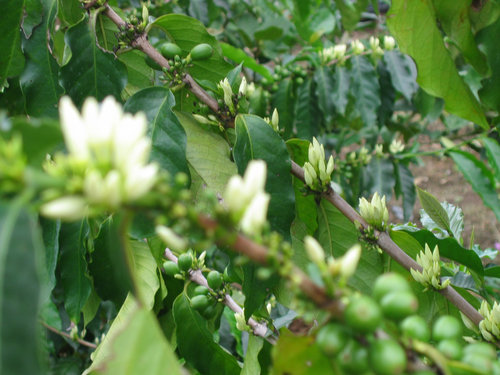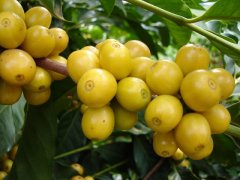Why is the deep-roasted coffee beans so smoky? is it normal for coffee beans to have a smoky smell?
For professional baristas, please follow the coffee workshop (Wechat official account cafe_style)
Baking degree and sweetness
"the deeper the baking, the stronger the sweet" means "the higher the sweetness," which is a misconception.
* Raw bean stage: sweetness has not yet begun to develop.
* heating and dehydration stage: the first half of the temperature is not enough to develop sweetness, and the temperature of the second half just reaches the starting point of the pyrolysis reaction of 160-170 degrees Celsius. At this time, there is "transsaccharification", and sweetness begins to develop.
* after dehydration, the temperature rises to an explosive stage: the sweetness continues to increase, but the bean body is not evenly ripe, so the internal astringent and sour taste intensity is higher than the sweet intensity.
* the stage from the beginning of the first explosion to the end of the first explosion: the sweetness continues to increase, the bean is nearly fully ripe at the end of the explosion, the internal astringent taste decreases, the sour taste is still strong, and the sweetness that can be detected by the taste begins to emerge.
* from the end of the first explosion to the early stage of the second explosion: in addition to the continuous "transsaccharification", the "caramelization" also quietly began to sneak away. "turn saccharification" is an important step to increase the intensity of sweet, "caramelization" will reduce the intensity of sweet, and then bring out some slightly coking aroma, increase the sense of hierarchy.
* from the beginning of the second explosion to the intensive stage of the second explosion: the "transsaccharification" is coming to an end, and the "caramelization" is at its peak, so the sweetness intensity will not increase any more, but will become weaker and weaker, and the coking effect will increase the bitterness and smoke taste of carbonization over time. In addition, some irritating "second explosion pungent smell" has been added.
* from the second explosion to the end of the second explosion: the sugar produced by "transsaccharification" is fully utilized by "caramelization" and transformed into caramel with lower sweetness. at this time, there is no sour factor, so the second explosion of the last bean will usually make people feel "bitter". If the second explosion bean is baked and cooked successfully, the bitter taste should be suppressed to a very low level, and it will taste a bit like high-purity dark chocolate "milk". The sweet taste is very long-lasting, but not strong.
Where does the smell of smoke come from?
Where does the smoke come from? It starts from how raw beans become ripe beans.
In order to transform raw beans into cooked beans that can be boiled, it must be baked at high temperature before it can produce "pyrolysis".
Pyrolysis is like the energy that drives the operation of machinery and equipment in a factory, which converts many "raw materials" in raw beans into "products".
Among them, the energy comes from the external "heat", with the addition of heat energy.
Just like we stir-fry at home, the fire food is burnt without careful control.
Most of the fried vegetables are carbohydrates, so the water is dried quickly by high heat in the process of scorching.
Therefore, it is impossible to maintain the original color of the dish and turn it into carbon black.
Carbon black is very close to charcoal, but it is not the end of its life.
The carbon will continue to burn until it turns to ashes.
When it burns, it still releases a lot of smoke.
Coffee beans are also carbohydrates in nature, so they are applicable in principle.
But coffee beans have another thing to pay attention to, that is, the silver skin attached to the appearance.
The silver skin does not have a certain thickness and moisture like the coffee bean body, so its moisture can be easily dried by high heat.
In addition, at a certain stage, the silver skin will peel off the coffee bean body, and at this time it is in the high heat stage that continues to heat up.
(roasted coffee beans will exceed 200 degrees Celsius)
In a hot and dry environment, the surface of coffee beans will smoke, not to mention the thin silver skin.
So how does the smell of smoke stay in the coffee beans? How to reduce the smell of smoke?
The answer is to "exhaust smoke".
If the tobacco row is smooth, the smell of smoke will not attach too much to the coffee beans.

Important Notice :
前街咖啡 FrontStreet Coffee has moved to new addredd:
FrontStreet Coffee Address: 315,Donghua East Road,GuangZhou
Tel:020 38364473
- Prev

The change of roasting degree and sweetness of coffee, where is the sugar?
For professional baristas, please pay attention to the baking degree and sweetness of the coffee workshop (official Wechat account cafe_style). "the deeper the roast, the stronger the sweetness." this is a misconception * raw bean stage: sweetness has not yet begun to develop * heating and dehydration stage: the first half is not warm enough to develop sweetness, and the temperature in the second half just reaches the starting point of the pyrolysis reaction.
- Next

Why can't you make a good cup of hand-made coffee?
Professional coffee knowledge exchange more coffee bean information Please follow the coffee workshop (Wechat official account cafe_style) Seven factors affecting hand-brewed coffee many friends said, why can't you make a good cup of hand-brewed coffee even though you have followed the steps? Now the editor exposes the common mistakes of making coffee from three angles! A good cup of hand-made coffee can be tasted
Related
- Beginners will see the "Coffee pull flower" guide!
- What is the difference between ice blog purified milk and ordinary milk coffee?
- Why is the Philippines the largest producer of crops in Liberia?
- For coffee extraction, should the fine powder be retained?
- How does extracted espresso fill pressed powder? How much strength does it take to press the powder?
- How to make jasmine cold extract coffee? Is the jasmine + latte good?
- Will this little toy really make the coffee taste better? How does Lily Drip affect coffee extraction?
- Will the action of slapping the filter cup also affect coffee extraction?
- What's the difference between powder-to-water ratio and powder-to-liquid ratio?
- What is the Ethiopian local species? What does it have to do with Heirloom native species?

